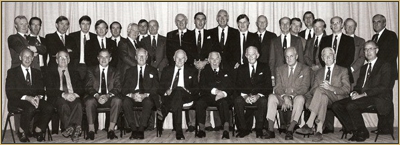Grey Turner Surgical Club
Welcome to the GTSC. The website is open to members only..
Please access the login page to browse the files, or to request access.
The Beginnings of the Grey Turner Club
George Grey Turner was an early 20th-century surgeon who became famous for his clinical and surgical skills. These, together with his academic vigour, teaching and lecturing ability, publications, organisational skills and farsightedness, made him known throughout the world.
He was one of the first British surgeons to regularly visit clinics overseas, starting with a trip to Vienna when he was a registrar. His initial visit to the Mayo Clinic (where?) took place in 1906.
He was appointed consultant surgeon at the Royal Victoria Infirmary, Newcastle, in 1920 and became Professor of Surgery at Durham University in 1927.
Surgeons from all over the world would come to Newcastle to watch Grey Turner operate. Elsie, his wife, could speak French, German and Spanish, which was a great advantage in his overseas visits, especially when he was received by the Spanish Royal Family.
When the new Postgraduate Medical School at the Hammersmith Hospital opened in 1934, he was invited to become Director of the Surgical Department. He remained at Hammersmith until 1947, when he retired aged 70. He died at home suddenly at the age of 73.
The Grey Turner Club was the brainchild of Gordon Bailey, who was a St Thomas’ graduate and a consultant surgeon in Harrogate. He and seven other surgeons met as guests of Professor Alan Stammers, the first Professor of Surgery in Birmingham.
Sadly, there are no records of the first meeting but it was decided that Grey Turner would be contacted, invited to become the first president and to have the club named after him. Grey Turner agreed but died eight months later, before he could attend a meeting.
The original eight Grey Turner members were:
- Gordon Bailey (St Thomas’ General Surgeon, Harrogate)
- Donald Marshall (Edinburgh Orthopaedic Surgeon)
- Guy Almond (Liverpool Orthopaedic Surgeon, Liverpool)
- James Conyers (St Thomas’ General Surgeon, York)
- Dick Franklin (St Thomas’ General Surgeon, Hammersmith)
- Ashton Miller (St Georges’ Urologist, Bath)
- David Beattie (Barts General Surgeon, Leicester)
- John Swinney (Newcastle Urologist, Newcastle)
Since 1951 there has been a meeting every year. Initially, centres in Great Britain were visited but, following a visit to Oslo in 1963, the club has aimed to have an overseas visit every third year.
The club membership has expanded and now has a limit of 25 active members and an unlimited number of retired members.
Naturally, the wives, husbands and partners of members are as important as the members themselves. On overseas visits, especially, there is plenty of time for social and cultural activities to be enjoyed in addition to the official surgical matters.
The Honorary Secretary runs the club, assisted by the Honorary Chronicler, who produces minutes of all the meetings, together with a synopsis of the presentations. These make for interesting reading.
The members themselves were initially mostly general surgeons, although there have been some orthopaedic surgeons and many urologists that have been members.

One of the great advantages of the club is that it is a forum where people with a particular interest have the opportunity to hear the experiences of, and learn lessons from, colleagues in other sub specialities. This is an opportunity of which Grey Turner would have approved.
The membership now covers the whole spectrum of what was once “General Surgery”.
The name Grey Turner is usually associated these days with a physical sign (bruising of the flanks that can indicate retroperitoneal haemorrhage). In his lifetime, George Grey Turner made a huge impression and inspired so many of his colleagues and his surgical trainees, both in Great Britain and overseas. At that time, he was without doubt the pre-eminent surgeon in England.
We like to think that the members of the Grey Turner Club continue to practice and promote surgery in a similar manner.

